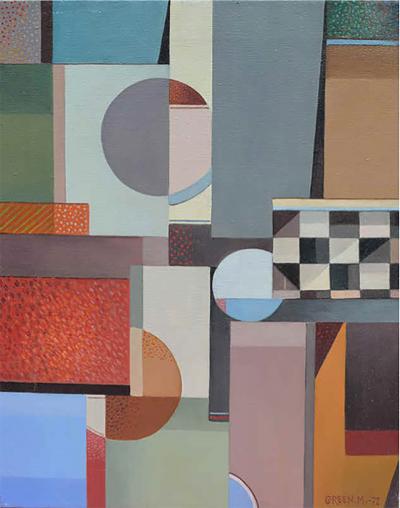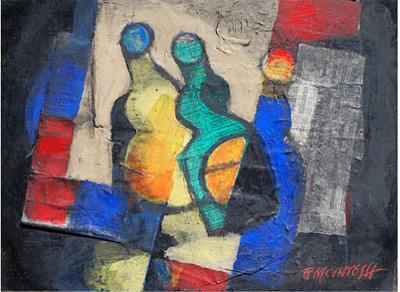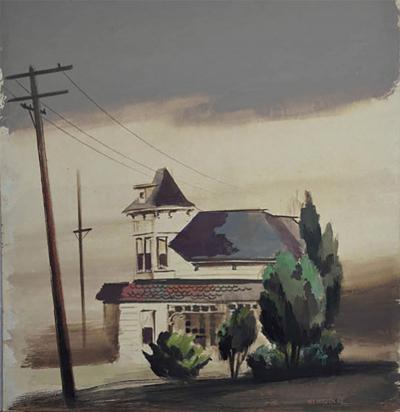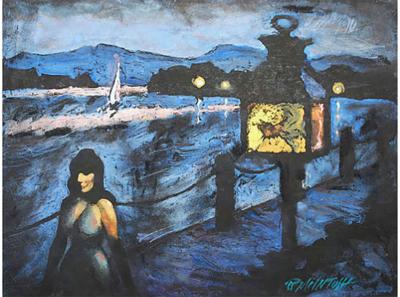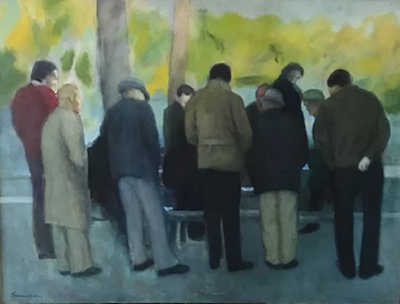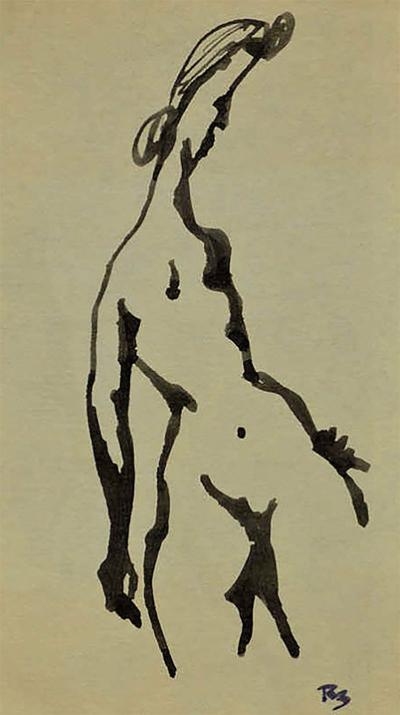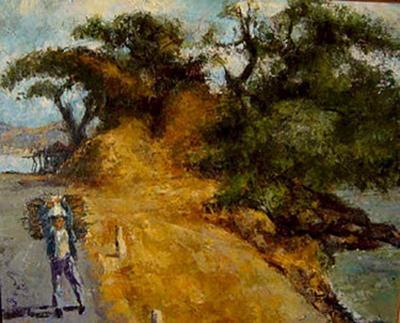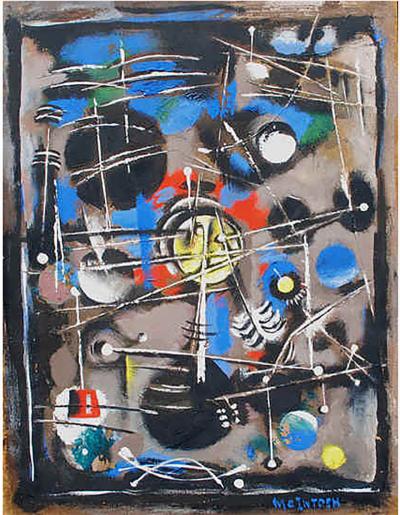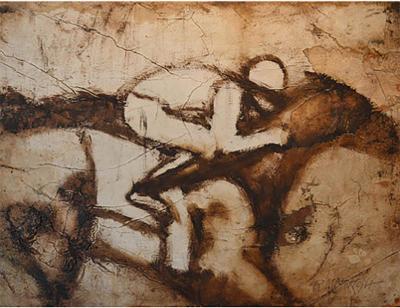Listings / Fine Art / Paintings / Figurative
"George's Bar"
-
Description
Joseph Delaney
"George's Bar"
Oil on Canvas
American, Signed, c.1942
Exhibited
31 x 39 Inches
Joseph Delaney
(1904-1991)
Though Joseph Samuel Delaney’s days began and ended in Knoxville, Tennessee, his artistic legacy was shaped by the half-century he spent living in New York City. The city—its activity, vitality, and, most significantly, its people—became his muse. A poet and essayist as well as painter, Delaney was enthralled with the urban experience, a delight that defined his expressive canvases.
The son of a Methodist minister, Joseph—along with his four surviving siblings, including the modernist artist Beauford Delaney—grew up in the heart of Knoxville’s “particularly sophisticated and educated black community.” During lengthy Sunday sermons, Joseph and Beauford whiled away the hours by drawing. A poor student, Delaney dropped out of school in the ninth grade, held a series of menial jobs, and for a number of years led a wanton life, a period he later described as “over-living.” In late 1922, he hopped a train out of Knoxville and led a hobo’s existence for the next six years, working itinerant jobs in Cincinnati, Detroit, Pittsburgh, and Chicago. A three-year stint in the Illinois National Guard awakened a sense of civic responsibility and upon his return to Knoxville in 1928, he became an adjunct preacher and established a Boy Scout troop for African American youth.
In 1930, Delaney moved to New York, where his brother Beauford had become a celebrity in the creative arts community of Greenwich Village. Joseph had nurtured his artistic passion even during his vagrant days and, upon his arrival in the city, immediately enrolled at the Art Students League, studying there full time through 1933. His instructors included Alexander Brook, George Bridgman, and, most significantly, Thomas Hart Benton. Benton’s aesthetic sensibilities resonated with the young artist, who developed friendships with his classmates, including Jackson Pollock, and attended the League’s Friday afternoon drawing classes until 1985. Along with his brother, Joseph Delaney participated in the first Washington Square Outdoor Art Exhibit in 1931 and thereafter became a regular exhibitor; he was one of the first artists to offer portrait sketches made on-site during the annual event. Later in his career, Delaney would execute portraits of Eleanor Roosevelt, Eartha Kitt, Tallulah Bankhead, and Eubie Blake, among other notables.
From 1934 to 1943, Delaney was a beneficiary of President Roosevelt’s New Deal arts initiative and held various positions with the Works Project Administration (WPA), including teaching art to inner city children, collaborating on public murals, and illustrating archival inventories. He was named to the WPA’s prestigious Easel Painting Division in 1943, the same year he embarked on a Julius Rosenwald travel grant. This award funded six months of touring up and down the eastern seaboard, from New England to South Carolina. The conclusion of these travels coincided with the end of the WPA and forced Delaney to the welfare rolls.
Over the next three decades, Delaney created what would become his signature works: urban scenes that celebrate the landmarks and liveliness of the city. His picaresque sketches were often executed in ballpoint ink on pocket-sized sketchpads for later development as finished studio pieces. With an emphasis on human connection, these canvases typically feature racially diverse figures depicted in a caricatural style—exaggerated forms that ignore anatomical scale and perspective in a cartoonish manner.
Several such works, including Central Park Skating, have been “identified as Delaney’s ‘postcard paintings.’” Described as “upbeat, promotional, and campy,” these genre scenes are “sentimental in their allusions to child-rearing and family interaction, a subject that obviously appealed to the bachelor artist.” In Central Park Skating, novice and skilled skaters circle the rink, set against a backdrop of Beaux-Arts Fifth Avenue hotels, in a scene reminiscent of Currier and Ives prints of an earlier generation. In contrast, other works by Delaney which portray the city’s bars and gambling clubs—featuring grim interiors and skeletal figures—reveal the artist’s familiarity with harsher urban realities.
In the 1970s, Delaney worked briefly as a visiting artist at the Henry Street Settlement Houses. On the heels of a major retrospective held in 1986 at the University of Tennessee, Delaney was named artist-in-residence there, an appointment facilitated by his friend, the Pulitzer-winning author Alex Haley. The honor included a campus house, and so Delaney left his beloved city to spend the remainder of his life in Knoxville.
Delaney, who described himself as a realist and “conservative conventionalist,” participated in more than thirty exhibitions during his lifetime. Three of the artist’s oil paintings were selected for inclusion in the landmark 1969 exhibit, Invisible Americans: Black Artists of the 1930s, held at the Studio Museum in Harlem. Of his own experience as an African American artist, Delaney wrote that “in the fine arts field, the mountain is not coming to Mohammed. . . . Many a black Daniel Boone is clearing rugged terrain and thick swamps and jagged cliff-sides with palette and brush.” He was also represented in important surveys of black art sponsored by Princeton University, the Brooklyn Museum, and Bellevue Art Museum, as well as the major 1982 exhibition, Parades: Paintings and Drawings of New York City Crowd Scenes; his 1943 canvas Penn Station at War Time toured with the Smithsonian-sponsored exhibition, African American Art: Harlem Renaissance, Civil Rights Era, and Beyond. Joseph Delaney’s works can be found in the nation’s premier museums, including the Metropolitan Museum of Art, Smithsonian American Art Museum, Chicago Art Institute, and National Academy of Design among others.
From The Johnson Collection -
More Information
Documentation: Signed Period: 1920-1949 Creation Date: 1942 Styles / Movements: Modernism Incollect Reference #: 591057 -
Dimensions
W. 39 in; H. 31 in; W. 99.06 cm; H. 78.74 cm;
Message from Seller:
Trigg Ison Fine Art Located in West Hollywood, CA, Trigg Ison Fine Art has been a recognized leader in early 20th-century figurative modern art for over 25 years, specializing in Art Deco and Modernist paintings and sculptures. Contact us at 310.274.8047 or contact@triggison.com to explore our curated collection of original modern art from Europe and the U.S.


















